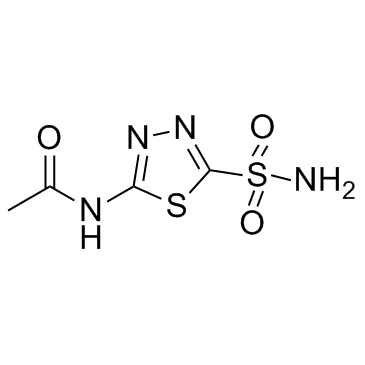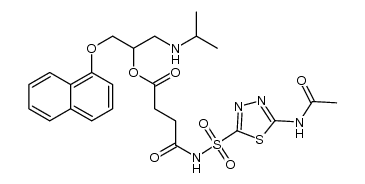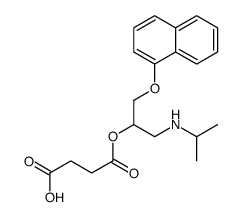59-66-5
| Name | acetazolamide |
|---|---|
| Synonyms |
Cidamex
Diamox Acetamide, N-[5-(aminosulfonyl)-1,3,4-thiadiazol-2-yl]- N-[5-(Aminosulfonyl)-1,3,4-thiadiozol-2-yl]-Acetamide DIACARB Glupax Donmox Acetamide, N-(5-(aminosulfonyl)-1,3,4-thiadiazol-2-yl)- Diluran N-(5-Sulfamoyl-1,3,4-thiadiazol-2-yl)acetamide 5-acetamido-1,3,4-thiadiazole-2-sulphonamide EINECS 200-440-5 acetazolamide Atenezol MFCD00003105 Didoc Edemox Diakarb |
| Description | Acetazolamide is a carbonic anhydrase (CA) IX inhibitor with an IC50 of 30 nM for hCA IX[1]. Diuretic effects[4]. |
|---|---|
| Related Catalog | |
| In Vitro | Acetazolamide also inhibits hCA II with an IC50 of 130 nM[1]. Acetazolamide (Ace) is a small heteroaromatic sulfonamide that binds to various carbonic anhydrases with high affinity, acting as a carbonic anhydrase (CA) inhibitor[2]. Compared with the control group, the high Acetazolamide concentration (AceH, 50 nM), Cisplatin (Cis; 1 µg/mL) and Cis combined with the low Acetazolamide concentration (AceL, 10 nM) treatments significantly reduces viability of Hep-2 cells[2]. Treatment with the Acetazolamide/Cis combination significantly increases the expression levels of P53, as both AceL+Cis and AceH+Cis treatments result in significantly increased P53 protein expression levels compared with the control group. The Ace/Cis combination treatment significantly reduces the bcl-2/bax expression ratio, and increases the expression of caspase-3 protein, compared with the control group. AceL, AceH, Cis and AceL+Cis treatments significantly reduce the bcl-2/bax ratio compared with the control group[2]. Combined Ace and Cis treatment effectively promotes apoptosis in Hep-2 cells[2]. Combined treatment with Ace/Cis markedly decreases the expression of AQP1 mRNA in Hep-2 cells. Both AceH and AceL+Cis treatments decrease the expression of aquaporin-1 (AQP1) mRNA in Hep-2 cells compared with the control group[2]. |
| In Vivo | Acetazolamide (40 mg/kg) significantly potentiates the inhibitory effect of MS-275 on tumorigenesis in neuroblastoma (NB) SH-SY5Y xenografts[3]. Acetazolamide (40 mg/kg) and/or MS-275 treatment reduce expression of HIF1-α and CAIX in NB SH-SY5Y xenograft[3]. Acetazolamide (40 mg/kg), MS-275 and Acetazolamide+MS-275 reduce expression of mitotic and proliferative markers in NB SH-SY5Y xenografts[3]. |
| Cell Assay | Cell Viability Assay[2] Cell line: Hep-2 cells and HUVECs Concentration: 10 nM and 50 nM Incubation time: 48 h Assay: The cell viability of Hep-2 cells and HUVECs is measured by MTT assay. Hep-2 cells and HUVECs in logarithmic growth phase are plated in 96-well plates. Following 48 h of drug treatment as indicated, 200 µL MTT (5 mg/mL) is added to each well. Cells are incubated with the MTT solution at 37°C for 4 h. Then, 150 µL DMSO is added for 5 min. The optical density (OD) values are measured at 490 nm with a Versamax Microplate reader. Note: Combined treatment effectively reduced viability in Hep-2 cells. |
| Animal Admin | In vivo studies[3] Animal model: 4-6 weeks-old female NOD/SCID mice Dosage: 40 mg/kg, intraperitoneal injection, every day for 2 weeks Administration: Mice are randomized into four groups (5 mice per group). The control and treatment groups receive intraperitoneal injections of vehicle (PBS) or Acetazolamide (40 mg/kg), MS-275 (20 mg/kg) or the combination, respectively, every day for 2 weeks. Experiments are terminated when tumor sizes exceed 2 cm3 in volume or animals show signs of morbidity. Tumor diameters are measured on a daily basis until termination. Note: Inhibited tumor growth of NB xenografts with significant anti-tumor growth potentiation effect. |
| References |
| Density | 1.7±0.1 g/cm3 |
|---|---|
| Melting Point | 256-261°C |
| Molecular Formula | C4H6N4O3S2 |
| Molecular Weight | 222.245 |
| Exact Mass | 221.988129 |
| PSA | 151.66000 |
| LogP | -0.26 |
| Index of Refraction | 1.641 |
| Water Solubility | <0.1 g/100 mL at 22 ºC |
|
SECTION 1: Identification of the substance/mixture and of the company/undertaking Product identifiers Product name: Acetazolamide REACH No.: A registration number is not available for this substance as the substance or its uses are exempted from registration, the annual tonnage does not require a registration or the registration is envisaged for a later registration deadline.
CAS-No.: 59-66-5 Relevant identified uses of the substance or mixture and uses advised against Identified uses: Laboratory chemicals, Manufacture of substances SECTION 2: Hazards identification Classification of the substance or mixture Classification according to Regulation (EC) No 1272/2008 Skin irritation (Category 2), H315 Eye irritation (Category 2), H319 For the full text of the H-Statements mentioned in this Section, see Section 16. Classification according to EU Directives 67/548/EEC or 1999/45/EC Xi IrritantR36/38 For the full text of the R-phrases mentioned in this Section, see Section 16. Label elements Labelling according Regulation (EC) No 1272/2008 Pictogram Signal wordWarning Hazard statement(s) H315Causes skin irritation. H319Causes serious eye irritation. Precautionary statement(s) P305 + P351 + P338IF IN EYES: Rinse cautiously with water for several minutes. Remove contact lenses, if present and easy to do. Continue rinsing. Supplemental Hazardnone Statements Other hazards - none SECTION 3: Composition/information on ingredients Substances Chemical characterization : Natural product Synonyms: N-(5-Sulfamoyl-1,3,4-thiadiazol-2-yl)acetamide Formula: C4H6N4O3S2 Molecular Weight: 222,25 g/mol CAS-No.: 59-66-5 EC-No.: 200-440-5 Hazardous ingredients according to Regulation (EC) No 1272/2008 ComponentClassificationConcentration Acetazolamide CAS-No.59-66-5Skin Irrit. 2; Eye Irrit. 2; H315,<= 100 % EC-No.200-440-5H319 Hazardous ingredients according to Directive 1999/45/EC ComponentClassificationConcentration Acetazolamide CAS-No.59-66-5Xi, R36/38<= 100 % EC-No.200-440-5 For the full text of the H-Statements and R-Phrases mentioned in this Section, see Section 16 SECTION 4: First aid measures Description of first aid measures General advice Consult a physician. Show this safety data sheet to the doctor in attendance. If inhaled If breathed in, move person into fresh air. If not breathing, give artificial respiration. Consult a physician. In case of skin contact Wash off with soap and plenty of water. Consult a physician. In case of eye contact Rinse thoroughly with plenty of water for at least 15 minutes and consult a physician. If swallowed Never give anything by mouth to an unconscious person. Rinse mouth with water. Consult a physician. Most important symptoms and effects, both acute and delayed The most important known symptoms and effects are described in the labelling (see section 2.2) and/or in section 11 Indication of any immediate medical attention and special treatment needed no data available SECTION 5: Firefighting measures Extinguishing media Suitable extinguishing media Use water spray, alcohol-resistant foam, dry chemical or carbon dioxide. Special hazards arising from the substance or mixture Carbon oxides, nitrogen oxides (NOx), Sulphur oxides Advice for firefighters Wear self contained breathing apparatus for fire fighting if necessary. Further information no data available SECTION 6: Accidental release measures Personal precautions, protective equipment and emergency procedures Use personal protective equipment. Avoid dust formation. Avoid breathing vapours, mist or gas. Ensure adequate ventilation. Avoid breathing dust. For personal protection see section 8. Environmental precautions Do not let product enter drains. Methods and materials for containment and cleaning up Pick up and arrange disposal without creating dust. Sweep up and shovel. Keep in suitable, closed containers for disposal. Reference to other sections For disposal see section 13. SECTION 7: Handling and storage Precautions for safe handling Avoid contact with skin and eyes. Avoid formation of dust and aerosols. Provide appropriate exhaust ventilation at places where dust is formed.Normal measures for preventive fire protection. For precautions see section 2.2. Conditions for safe storage, including any incompatibilities Store in cool place. Keep container tightly closed in a dry and well-ventilated place. Light sensitive. Specific end use(s) A part from the uses mentioned in section 1.2 no other specific uses are stipulated SECTION 8: Exposure controls/personal protection Control parameters Components with workplace control parameters Exposure controls Appropriate engineering controls Handle in accordance with good industrial hygiene and safety practice. Wash hands before breaks and at the end of workday. Personal protective equipment Eye/face protection Safety glasses with side-shields conforming to EN166 Use equipment for eye protection tested and approved under appropriate government standards such as NIOSH (US) or EN 166(EU). Skin protection Handle with gloves. Gloves must be inspected prior to use. Use proper glove removal technique (without touching glove's outer surface) to avoid skin contact with this product. Dispose of contaminated gloves after use in accordance with applicable laws and good laboratory practices. Wash and dry hands. The selected protective gloves have to satisfy the specifications of EU Directive 89/686/EEC and the standard EN 374 derived from it. Full contact Material: Nitrile rubber Minimum layer thickness: 0,11 mm Break through time: 480 min Material tested:Dermatril® (KCL 740 / Z677272, Size M) Splash contact Material: Nitrile rubber Minimum layer thickness: 0,11 mm Break through time: 480 min Material tested:Dermatril® (KCL 740 / Z677272, Size M) data source: KCL GmbH, D-36124 Eichenzell, phone +49 (0)6659 87300, test method: EN374 If used in solution, or mixed with other substances, and under conditions which differ from EN 374, contact the supplier of the CE approved gloves. This recommendation is advisory only and must be evaluated by an industrial hygienist and safety officer familiar with the specific situation of anticipated use by our customers. It should not be construed as offering an approval for any specific use scenario. Body Protection impervious clothing, The type of protective equipment must be selected according to the concentration and amount of the dangerous substance at the specific workplace. Respiratory protection For nuisance exposures use type P95 (US) or type P1 (EU EN 143) particle respirator.For higher level protection use type OV/AG/P99 (US) or type ABEK-P2 (EU EN 143) respirator cartridges. Use respirators and components tested and approved under appropriate government standards such as NIOSH (US) or CEN (EU). Control of environmental exposure Do not let product enter drains. SECTION 9: Physical and chemical properties Information on basic physical and chemical properties a) AppearanceForm: powder b) Odourno data available c) Odour Thresholdno data available d) pHno data available e) Melting point/freezingMelting point/range: 258 - 259 °C point f) Initial boiling point and no data available boiling range g) Flash pointno data available h) Evapouration rateno data available i) Flammability (solid, gas) no data available j) Upper/lowerno data available flammability or explosive limits k) Vapour pressureno data available l) Vapour densityno data available m) Relative densityno data available n) Water solubilityno data available o) Partition coefficient: n- no data available octanol/water p) Auto-ignitionno data available temperature q) Decompositionno data available temperature r) Viscosityno data available s) Explosive propertiesno data available t) Oxidizing propertiesno data available Other safety information no data available SECTION 10: Stability and reactivity Reactivity no data available Chemical stability Stable under recommended storage conditions. Possibility of hazardous reactions no data available Conditions to avoid no data available Incompatible materials Strong oxidizing agents Hazardous decomposition products Other decomposition products - no data available In the event of fire: see section 5 SECTION 11: Toxicological information Information on toxicological effects Acute toxicity LD50 Oral - mouse - 4.300 mg/kg Skin corrosion/irritation no data available Serious eye damage/eye irritation no data available Respiratory or skin sensitisation no data available Germ cell mutagenicity no data available Carcinogenicity IARC:No component of this product present at levels greater than or equal to 0.1% is identified as probable, possible or confirmed human carcinogen by IARC. Reproductive toxicity no data available Specific target organ toxicity - single exposure no data available Specific target organ toxicity - repeated exposure no data available Aspiration hazard no data available Additional Information RTECS: AC8225000 Headache, fatigue, Anorexia., Gastrointestinal disturbance, Drowsiness, To the best of our knowledge, the chemical, physical, and toxicological properties have not been thoroughly investigated. SECTION 12: Ecological information Toxicity no data available Persistence and degradability no data available Bioaccumulative potential no data available Mobility in soil no data available Results of PBT and vPvB assessment PBT/vPvB assessment not available as chemical safety assessment not required/not conducted Other adverse effects no data available SECTION 13: Disposal considerations Waste treatment methods Product Offer surplus and non-recyclable solutions to a licensed disposal company. Contact a licensed professional waste disposal service to dispose of this material. Dissolve or mix the material with a combustible solvent and burn in a chemical incinerator equipped with an afterburner and scrubber. Contaminated packaging Dispose of as unused product. SECTION 14: Transport information UN number ADR/RID: -IMDG: -IATA: - UN proper shipping name ADR/RID: Not dangerous goods IMDG: Not dangerous goods IATA:Not dangerous goods Transport hazard class(es) ADR/RID: -IMDG: -IATA: - Packaging group ADR/RID: -IMDG: -IATA: - Environmental hazards ADR/RID: noIMDG Marine pollutant: noIATA: no Special precautions for user no data available SECTION 15 - REGULATORY INFORMATION N/A SECTION 16 - ADDITIONAL INFORMATION N/A |
CHEMICAL IDENTIFICATION
HEALTH HAZARD DATAACUTE TOXICITY DATA
|
| Symbol |

GHS07 |
|---|---|
| Signal Word | Warning |
| Hazard Statements | H315-H319 |
| Precautionary Statements | P305 + P351 + P338 |
| Personal Protective Equipment | dust mask type N95 (US);Eyeshields;Gloves |
| Hazard Codes | Xi:Irritant |
| Risk Phrases | R36/38 |
| Safety Phrases | S26 |
| RIDADR | 2811 |
| RTECS | AC8225000 |
| Packaging Group | III |
| Hazard Class | 6.1 |
| HS Code | 2935009090 |
|
~72% 
59-66-5 |
| Literature: Tetrahedron Letters, , vol. 54, # 45 p. 5945 - 5947 |
|
~% 
59-66-5 |
| Literature: Journal of the American Chemical Society, , vol. 78, p. 4649,4652 |
|
~% 
59-66-5 |
| Literature: Oriental Journal of Chemistry, , vol. 27, # 1 p. 173 - 178 |
| Precursor 3 | |
|---|---|
| DownStream 2 | |
| HS Code | 2935009090 |
|---|---|
| Summary | 2935009090 other sulphonamides VAT:17.0% Tax rebate rate:9.0% Supervision conditions:none MFN tariff:6.5% General tariff:35.0% |







